If somebody would tag today’s post, the outcome probably would be something like: ‚Europeana Network Association | Europeana 1914-1918 | Europeana 1989 | annual general meeting | copyright | licenses | OpenGLAM | impact assessment‘. Would you read this post?
Let’s add: ‚passion for culture and history | human feelings | courage | societal responsibility | happy people‚. Now we are talking!
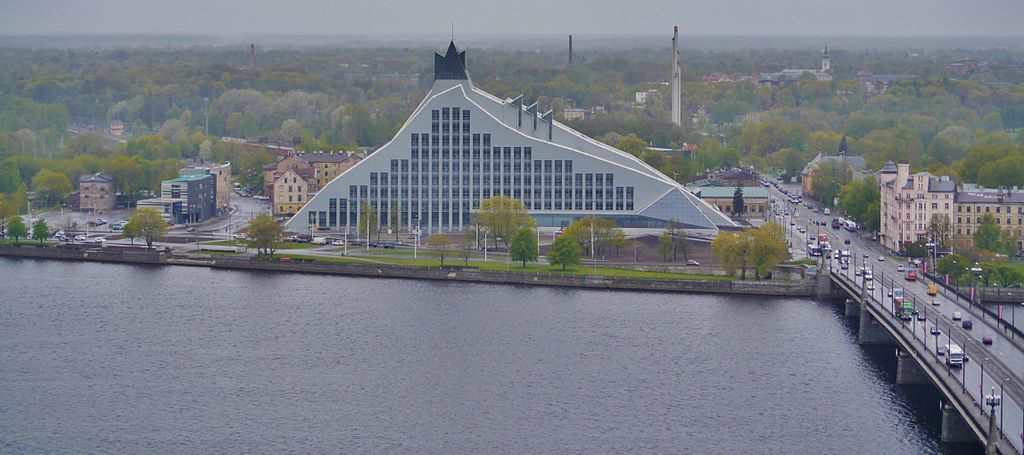
View from the Tower of St. Peter’s Church to the Latvian National Llibrary, Riga, Latvia‚ The Latvian National Llibrary, also called ‚The Castle of Light‘, has been designed by Gunnar Birkerts (in Latvian: Gunārs Birkerts) and is venue of the ‚Europeana Network Association Annual General Meeting 2016, November 8+9. Source: Wikimedia Commons, picture by Zairon, CC BY-SA 4.0
This is my third post on Europeana. Why? Can somebody be inspired not only by art and culture, but also by an international institution? I am enthusiastic about the activities of Europeana.
What is Europeana?
Europeana does not only offer the Internet Portal ‚Europeana Collections‚ with more than 53 million artworks, artifacts, books, videos and audios from all over Europe. Data of almost 4,000 European cultural heritage institutions are available in a standardised presentation platform. If you take a closer look at the website, you will also find a huge amount of projects, virtual exhibitions and blog posts. Data are collected, processed and linked and even used in exemplary online exhibitions. Underlying technology is driven further. Projects which are mostly implemented together with many different partners, aim to inspire use and re-use of data in many different areas. Furthermore Europeana is fighting on the front line for a fairer copyright system in Europe – and offers us a great service in this complicated, unappealing area!
Open licensing – who benefits? The OpenGLAM mindset
How ‚human-centered‘ is the issue of licensing data? Regarding to the licencing policy of institutions that are donating data to Europeana Collections, Europeana can take a critical stance, as reported earlier this year by Karin Glasemann from the National Museum in Stockholm (pdf, in German, Open Access as a catalyst for internal development. How collaboration with Europeana, Wikimedia and Linked Open Data initiatives changed the inside view of the museum, p. 4 ):
„Our collections were praised and respected, but Europeana itself was unmistakable in its judgment: while the collection was praised as an enrichment of the portal, the critical demand prevailed as to why the material was not reusable.“
In the second half of her paper, Karin Glasemann tells how positive the subsequent release of the data for free re-use (CC BY-SA) has worked out – outside of but also within the walls of the Swedish National Museum. Recently it has further opened its collection, handing over more than 3,000 high-resolution images to Wikimedia Commons and GitHub for free download and re-use, marked ‚public domain‘. Enjoy the artworks on Wikimedia; they will also be available in Europeana Collections soon.
Are you interested in a more visual and vivid presentation of advantages and possible shady sides of OpenGLAM (Open Galleries, Libraries, Archives and Museums)? Take a look at the latest Slideshare of Merete Sanderhoff: ‚Sharing is Caring. Societal impact of open collections?‚. Intentionally and in the end OpenGLAM, open licenses and ‚Europeana technology‘ is all about giving culture in the hands of people – because culture belongs to them.
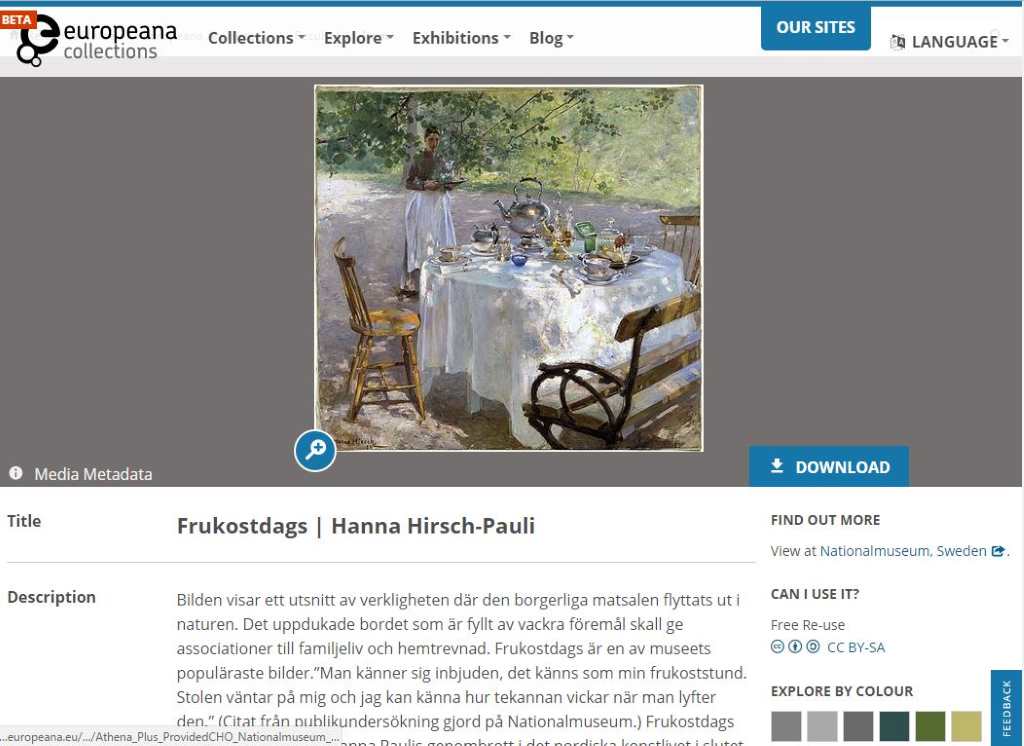
Screenshot of Hanna Pauli’s ‚Breakfast Time‚ (Collection National Museum, Stockholm) on ‚Europeana Collections‘, ready for download, free to re-use.
A human face? Europeana 1914-1918
A project / website like ‚Europeana 1914-1918‘ demonstrates that ‚data ‚can equal deep human feelings and sometimes dramatic events. The homepage states:
„Europeana 1914-1918 – untold stories & official histories of WW1. Explore stories, films and historical material about the First World War and contribute your own family history. Europeana 1914-1918 mixes resources from libraries and archives across the globe with memories and memorabilia from families throughout Europe. Discover. Learn. Research. Use. Share.“
Users have the opportunity to add their private (scanned) objects, related memories and stories online at any time. Since 2011, however, in addition ‚Community Collection Days‘ are being organized by Europeana and partners in almost every European country. Descendants of persons involved in WW1 can show their memorabilia and get them digitized on the spot. They are invited to tell the tales connected with those objects. Sometimes they also reveil the interpretations and emotions they connect to hem – because there are human ears that are listening and not only audio equipment! Europeana is so much more than a ‚data harvesting machine‘.
Some 200,000 private memorabilia have already been digitized and ’storified‘ on this website!
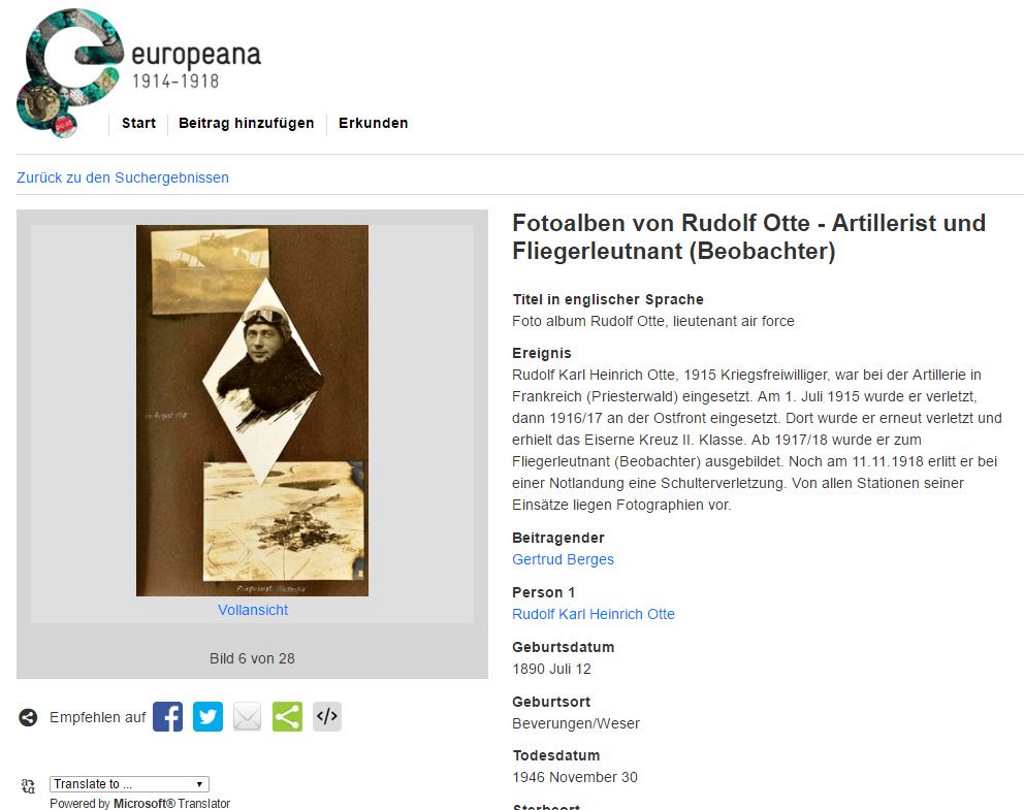
User contributed, completely digitized photo album of lieutenant air force Rudolf Otte (screen shot Europeana 1914-1918).
What Europeana 1914-1918 is all about
Harry Verwayen, Deputy Director of Europeana, has participated in Community Collection Days in Poznan / Poland in June. He writes about what happened over there in a blog post ‚A family with no history is not a family at all‚. He concludes:
„I left Poznan reinvigorated and with the feeling that collecting people’s stories is as important as digitizing the objects and safeguarding them for the future. How do we make sure future generations can not only read the facts but also understand the emotions behind the metadata? How do we translate the energy that is unleashed when people ‘unload’ their story by expressing them to us in a room, to a compelling online experience? Currently they end up being part of a large corpus of individual narratives but we have yet to uncover the pan-European story that runs through all of them. This will require a lot of work to transcribe and translate the texts. But if we don’t do this we will have failed. A European union without a history is no union at all“
This is a wonderful testimony of how individual, personal objects, memories and stories come together with 800,000 documents from national libraries and more than 660 hours of footage. But by only digitising the job is really not done; there remain tasks, it’s about enabling relevance for and in everyday life, it’s about enabling people feeling part of a vivid history and not only of today’s here and now.
This is why I am enthusiastic about Europeana. The whole spectrum of technology, copyright, licensing, cooperation with thousands of institutions AND thousands of ‚ordinary people‘ of all European countries, with focus on enabling and creating understanding of and respect for cultural diversity, on making people feel part of history and mankind, feeling citizens of their region, their country, of Europe and the rest of the world. To me this is beautifully expressed by former Europeana Icon Nick Poole in his ‚Europeana Dream‚ (video). I will keep on dreaming this dream.
How to measure the ‚project results‘? Is there significant change for people?
A few weeks ago Europeana published a case study combined with a video in which the attempt is made to determine the Europeana 1914-1918 project results in a businesslike way – trying to present „measurable outcomes that can demonstrate a significant change for people“ (‚Workers underground. An impact assessment case study – Europeana 1914-1918‚; pdf, p. 5). Blog post ‚A fresh perspective on exploring impact‚ introduces this case study and the video. Harry Verwayen was one of the persons in charge. Well, did a kind of Return on Investment-thinking make him forget about human emotions, converting them to cold-hearted numbers? Not at all, watch the video!
Project managers and decision-makers want figures, want clear insights in return on investment – that’s quite reasonable. In general it would be very useful if workers in the cultural and cultural heritage sector would have tools and skills to make their ‚results‘ more visible to policy makers and funders. We really cannot rely only on things like totals of page views, downloads, Twitter impressions or physical visits to our institutions … In addition, impact assessment can help you as a ‚culture worker‘ to sharpen your own view and merge false suppositions!
In my opinion this effort of Europeana is very brave and a great attempt. Perhaps the read of the case study will inspire you and some thoughts might be applicable to your own projects in some way or another. I will not further comment on video and case study. You are cordially invited by Europeana to do so yourself, on social media via #europeanaimpact, or by email at impact@europeana.eu, as expressed in the cited blog post.
The upcoming Annual General Meeting 2016 in Riga – boring?
8 and 9 November the Annual General Meeting of the Europeana Network Association will take place in Riga / Latvia. I will participate. Why?
Merely a term like ‚annual general meeting‘ is definitely not something that is likely to attract me. Spontaneously I feel remembered of dutiful events with partly dreary financial reports and budget negotiations. The 2015 AGM from Europeana in Amsterdam has taught me something better. For an ‚institute‘ – and a European one on top – the atmosphere was very lively, at times cosy and without arrogance. A representative of the European Commission did some pretty straight talking.The main components were presentations, workshops, exchange – playful and well-organized. This year the 2013 accomplished new building of the National Library of Latvia in Riga is the inviting venue, and the program is wonderful! It even includes a reception at the newly renovated main building of the Latvian National Museum of Art that I was not able to see last year.
Further on 28 new members of the Members Council will be elected; they will be working on several issues for the next 2 years in Task Forces and Working Groups.
In my opinion it would be good for Europeana and for all of us, if end users, culture bloggers, GLAM professionals and ‚culture workers‘ of every kind would engage themselves more and would have stronger connections with Europeana: ‚Together stronger‘. It is no coincidence that this blog post is being published as a contribution to a (German) blog about art, culture & social media, created and managed by wonderful art historian and-much-more Tanja Praske: ‚Culture – Museum – Talk‘. Thank you, Tanja, for having me here – the first post in English on your blog → Champagne!
Riga, the Baltic States and the ‚Baltic Way‘
The Baltic States have been seeing a turbulent history for centuries. Riga is a place that invites us to think about the complex issue of diversity, of regional, ethnical, religious, national and European identities. Some years ago Europeana launched ‚Europeana 1989‚, which reflects the same approach as ‚Europeana 1914-1918‘. The home page states:
„The way history is recorded isn’t just about what museums and institutions think is important, it’s about what real people lived through and experienced. Do you have stories, pictures, films or other items relating to the events of 1989 in Central and Eastern Europe? Add them to our online collection and share them with the world! Or let us take you on a journey through the Fall of the Iron Curtain, see it from all sides and draw your own conclusions.“
What real people lived through‘ in the Baltic States was getting at least to some extent clear to the rest of the world by the the impressive ‚Baltic Way‚. Citing Wikipedia:
„On 23 August 1989 approximately two million people joined their hands to form a human chain spanning 675.5 kilometres across the three Baltic states […]. The protest was designed to draw global attention by demonstrating a popular desire for independence for each of the entities. It also illustrated solidarity among the three nations.“
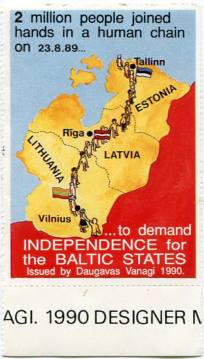
Baltijas ceļam veltīta pamarka / Postage Stamp dedicated tot he Baltic Way, User contributed content, marked Public Domain, in Europeana Collections
Europeana paid attention to the ‚Baltic Way‘ 25 years later on, inviting people to pin their memories online on a digital and zoomable map of the area. The Baltic Way crossed also Riga … Worth remembering, now we are heading for the AGM.
(We) Transform the world with culture?
Europeana’s Mission Statement:
„We transform the world with culture! We want to build on Europe’s rich heritage and make it easier for people to use, whether for work, for learning or just for fun.“
We transform? Sounds a little arrogant? Hear Beth Daley from Europeana asking questions in her blog post ‚We transform the world with culture. Say, what?‚:
„We – who? Transform – how? The world – it’s a big place! With culture – what’s that?
To me, these words have quite a variety of meanings. ‘We’ could be the Europeana Foundation, the Network Association or humankind. To ‘transform’ something, you change something from one state to another. So what is the process here and how do ‘we’ do that?“
I like to take it as an invitation for myself. And I will not forget that it is ultimately the ‚user‘ who changes the world – see the projects mentioned above! Do you agree with this interpretation?
To be honest, I’m happy that the Europeana 1914-1918 video ‚Workers Underground‘ (mentioned earlier in this post) simply states:

Still (5:36) from video ‚Workers Underground – a visual impact assessment journey of Europeana 1914-1918‘.
What are your views on Europeana? What do you like and what not? What would you recommend to Europeana? Please let me know!
I will take your remarks with me to Riga – in case you are not getting a member of the network yourself and will enjoy the AGM (see the Rules for Reimbursement of Travel and Subsistence Expenses).
My former articles on Europeana, in German:
Europeana – was und wem nutzt sie? #CultJam15 (2015, July 22).
Update Europeana – Was und wem nutzt sie? #CultJam15 (2015, September 17).
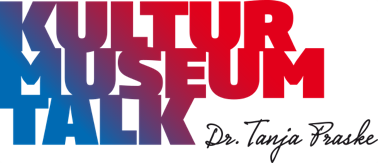

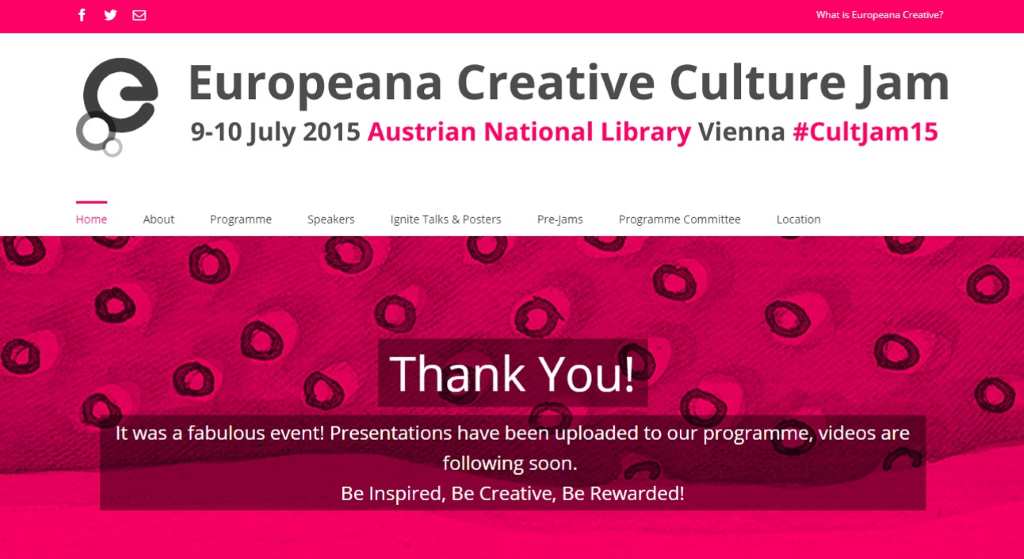
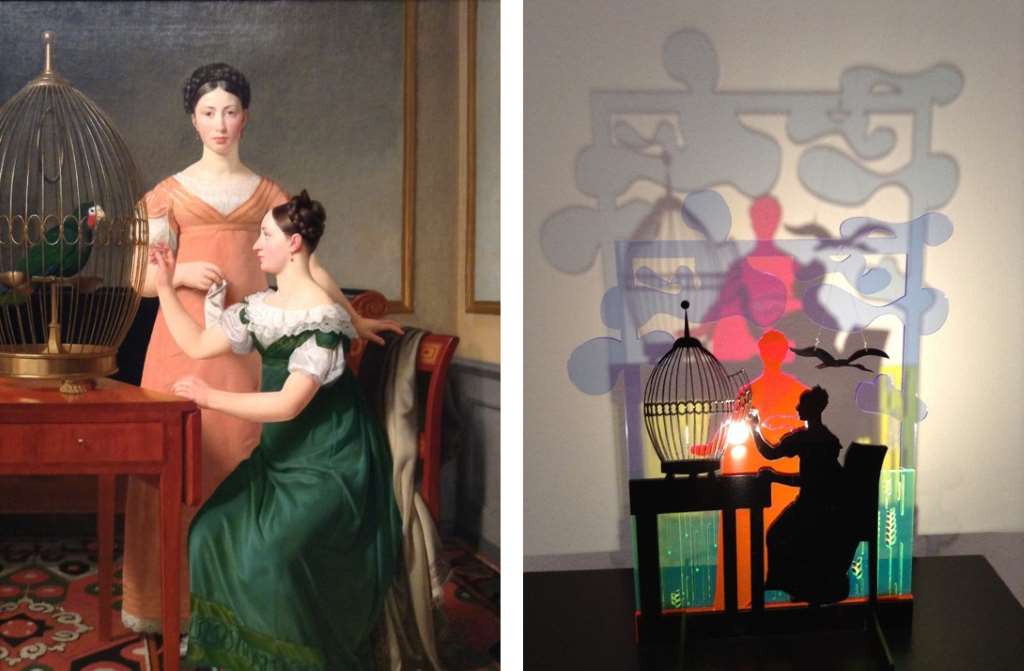
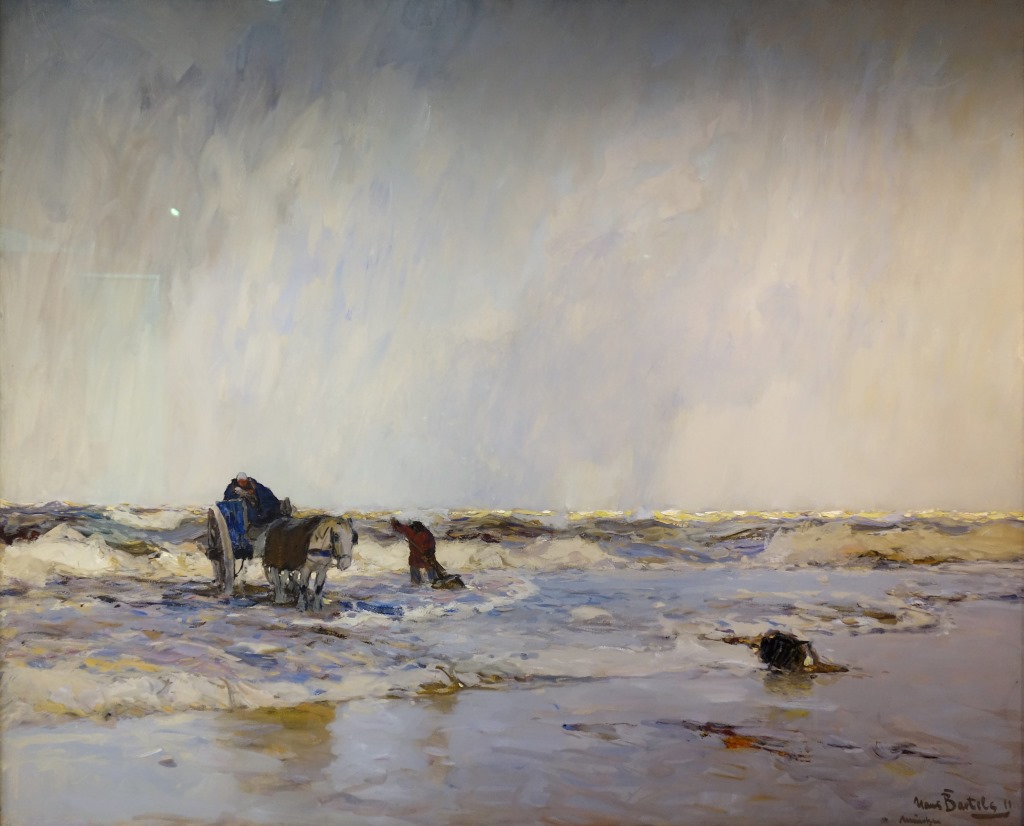
Dear Peter,
I really appreciate your engagement to bring the idea of Europeana near to me and all the others working in the cultural sector. This is so great and I can feel your heartblood in it!
My problem is the language. English is not my working language – it is not that easy for me to read. Especially when I’m only scanning through the amount of possibilities inside the huge project of Europeana. But please don’t stop in giving hints and pings to me. Maybe some day I realize, where I can start to dive in it.
Best wishes and hugs
Anke
Dear Anke,
thank you so much for your honest comment. Honest responses really bring further! I just returned from Riga; at the AGM the need of multilingualism was articulated several times. Your comment adds to that voices. And: for sure native English speakers will sometimes laugh at my ‚English‘. :)
Have happy times!
Peter
Peter, in fact you inspired me to join Europeana network – after all those posts and tweets :-)
All the best,
Marlene
Impossible to get a nicer compliment, Marlene! Thank you, enjoy being a member! I almost not dare to say it … return on investment :)